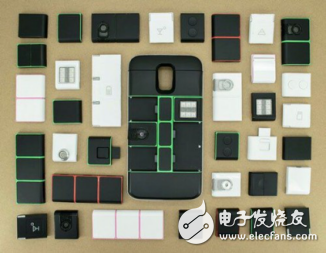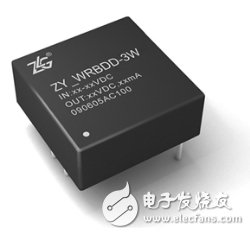Four selection problems of power modules in embedded system design
The emergence of power modules frees embedded engineers from the arduous power supply design work. However, there are many types of power modules. How do we consider the selection in daily circuit design?
In the increasingly fierce market competition, the rapid design and development of products has undoubtedly become a necessary condition for leading and winning business opportunities. Modular development, platform development, and program-based development have been accepted by more and more system designers and hardware engineers in the general case of project managers' “spurs†and shorter project cycles.

Figure 1 Modular design product - modular mobile phone
The development of any electronic product can't escape the design of the power supply. If the product is like a human, then the power is like a person's heart, the health of the heart is related to the survival of people. Similarly, the design of the power supply is good or bad, which affects the performance of the entire product, and affects the success or failure of the entire project. The power supply design, with its high degree of professionalism, long debugging cycle, difficult troubleshooting, etc., makes the "siege lions" hate.
In this context, the module power supply came into being, bringing the gospel to the "siege lions". Among them, the DC/DC power supply module is widely used in communication, network, industrial control, railway and other fields due to its remarkable features such as small size, excellent performance, convenient use and low comprehensive cost.
Then, in the various types of power modules with different models and different brands, how to filter out DC/DC power modules that are suitable and cost-effective? The general standard selection method is familiar to everyone. This time we talk about different points. We will talk about several problems that are easy to entangle when selecting DC/DC power modules during embedded system design.
First, isolation or non-isolation?“Does this part of the circuit need isolation?†This is basically a question that every embedded system engineer will think about.
For the purpose of isolation, isolation can be divided into two categories: safety isolation and noise isolation. Due to the wide application of embedded systems, in hardware design, it often encounters multi-voltage power supply, digital-analog mixing, high-speed and low-speed signals on the same board and other complex situations. If the processing is slightly inadvertent, it will introduce interference and reduce it. Product performance, but also interfere with communication and even cause system restart, smashing, etc. At this time, isolation is particularly important. In the design of embedded systems, it is generally preferred to use isolated power modules to isolate and power different blocks of the PCB, thereby minimizing noise interference and improving system stability.

Figure 2 Zhiyuan electronic 3W wide voltage isolated power module
In addition, in embedded systems with industrial buses, there are often harsh environments such as surges, arc interferences, and lightning strikes. Therefore, it is necessary to safely isolate the bus portion from the embedded system. Isolation not only eliminates the interference of the ground loop, but also blocks the adverse environmental factors from entering the core system through the bus to ensure the safety of the core system.
Second, performance VS cost?"Performance" and "cost" are a pair of loved ones. How many engineers are faced with dilemmas, and how many hard-working plans have to be abandoned due to cost issues. Is it for performance regardless of cost? Or sacrifice performance for cost? How to balance performance and cost is an unchanging topic in product design.

Figure 3 Performance and cost battle
For DC/DC power modules with the same input and output voltage, the output power and operating temperature range are the main factors affecting their cost. The operating temperature range of electronic devices is generally divided into: commercial grade (0~70 °C), industrial grade (-40~85 °C), vehicle gauge grade (-40~105 °C), military grade (-55~125 °C) and so on. Due to the different temperature grades and different requirements for materials and manufacturing processes, the module costs vary greatly.
If the actual power used in a certain volume (package form) condition is close to the rated power of the module, the nominal temperature range of the module must strictly meet the actual use requirements or even a slight margin. If a product with a smaller temperature range is selected due to cost considerations, and the actual operating temperature has approached the limit temperature of the module, what should I do? At this time, derating can be used, that is, selecting a product with a larger power or a larger package, so that the "large horse-drawn car" has a low temperature rise and can alleviate this contradiction to some extent.
In short, either the product with a wide temperature range is selected, the power utilization is more adequate, the package is smaller, but the price is higher; or the product in the general temperature range is selected, the price is lower, the power margin and the package form are larger. In the end, how to choose, we need to consider it according to the actual situation.
3. How much is the power margin left? 10%, 20%, or 30%?"Design margin", an indicator that people love and hate. The essence of the design of the margin is to prevent accidents. Although it has nothing to do with quality, the design of the margin is insufficient, there will be hidden dangers of quality problems, and the margin design is too large, which will cause the cost to rise.
Due to the wide application of embedded systems, the load is also diverse, some are resistive loads, some are inductive or capacitive loads, some are more stable, some have large fluctuations, and some may even have no load, or Full load, or instantaneous load becomes large, or instantaneous load drop occurs, which makes it difficult to determine the power level of the power module.

Figure 4 Embedded development is widely used
Under normal circumstances, the magnitude of the load current is the key factor determining the power. In order to consider the stability and anti-accident capability of the embedded system design, it is recommended to reserve a minimum design margin of 20% according to the actual situation, which is the largest in actual use. The power does not exceed 80% of the rated power of the power module. In this power range, the performance of the power module is fully and stable. If the margin is too large, it will cause waste of resources. If the margin is too small, it will be detrimental to temperature rise and reliability.
For the fluctuating load, the design should meet the basic principle that the peak current does not exceed the maximum bearing range of the power module, and then increase the design margin according to the frequency of the load fluctuation to maximize the reliability.
Fourth, the greater the isolation voltage, the better?Isolation voltage is an important indicator of isolated DC/DC power modules. It is generally divided into 1000VDC, 1500VDC, 2000VDC, 3000VDC, 6000VDC and other specifications. It refers to the power module that can withstand and apply within a certain period of time (usually 1 second). The highest voltage between the input and output. The higher the isolation voltage level, the higher the protection device and design process requirements inside the power module. Basically, the higher the cost. So how do you choose the right isolation voltage?
The isolation voltage of the power module needs to be selected according to the application. In general, the isolation voltage requirement for the power module is not very high, but the higher isolation voltage can ensure that the module power supply has less leakage current, higher safety and reliability, and better EMC characteristics, and embedded The system core device has high integration, small package, and relatively fragile. Therefore, the general application industry has a common isolation voltage level of 1500 VDC or above. However, in some special industries, such as medical, outdoor communication base stations, high-voltage power, etc., the isolation requirements for power modules are higher.
At the moment of rapid development of technology, rapid product development has become a normalization, the powerful processing power of embedded systems, weakened the hardware design, and handed over a lot of work to the software. Standardized hardware platforms, standard interfaces, and rich drivers make it possible to quickly prototype products into the market. In the increasingly compact project cycle, more and more embedded system design engineers have strongly realized that the correct and reasonable selection of DC/DC power modules can not only save the trouble of power supply design and debugging, but also Improve the reliability and design level of the overall system, and more importantly, shorten the development cycle of the entire product.
At present, flat Zinc bar is the ideal material for the zinc static and dynamic balance block of vehicle wheel, with good corrosion resistance.
Excellent mechanical properties,elongation is up to 20% or more,the yield of balance pieces stamping is high.
Product specification: Ñ„19mm(width)*2.65mm(thick)
Product packing: 30-150kgs(special packaging specifications can be negotiated)
Flat Zinc Bar,Anode Zinc Bar,Galvanized Zinc Flat Bar,Zinc Coated Steel Flat Bar
Shaoxing Tianlong Tin Materials Co.,Ltd. , https://www.tianlongspray.com